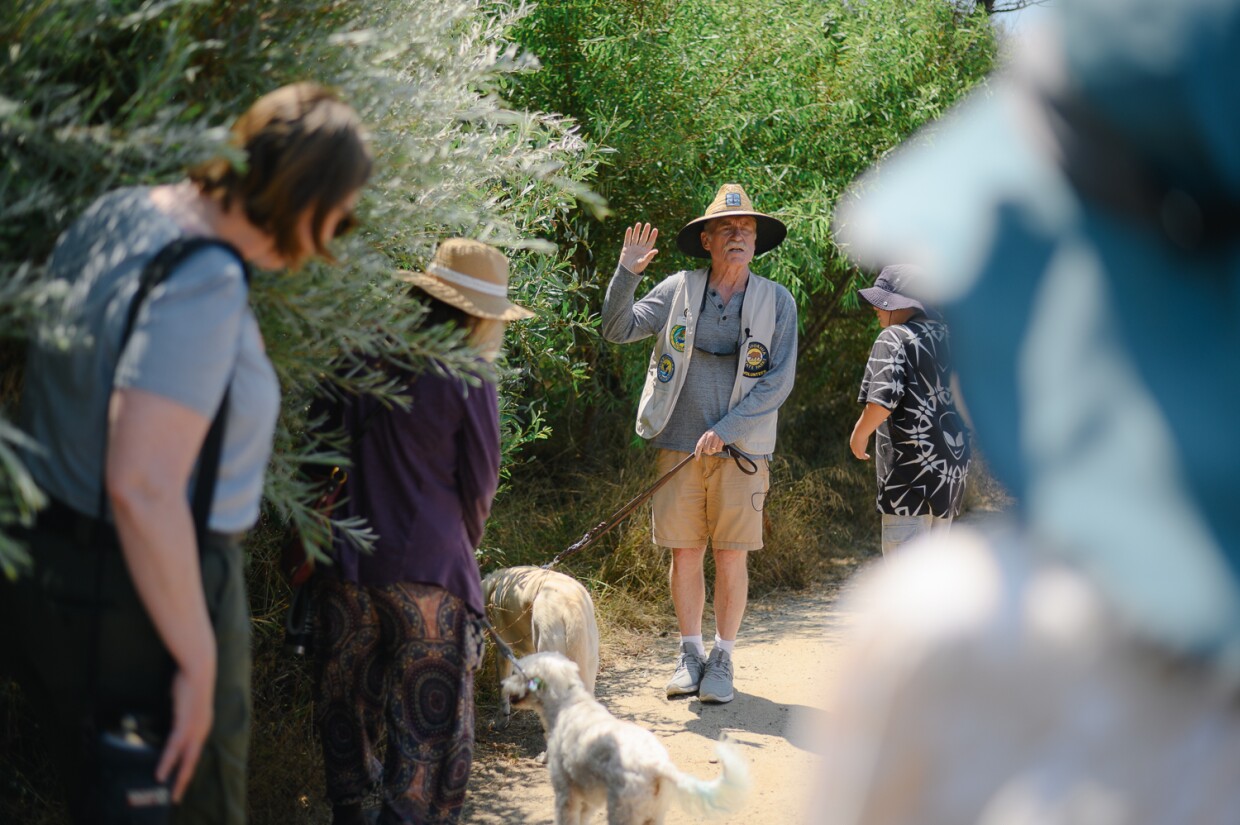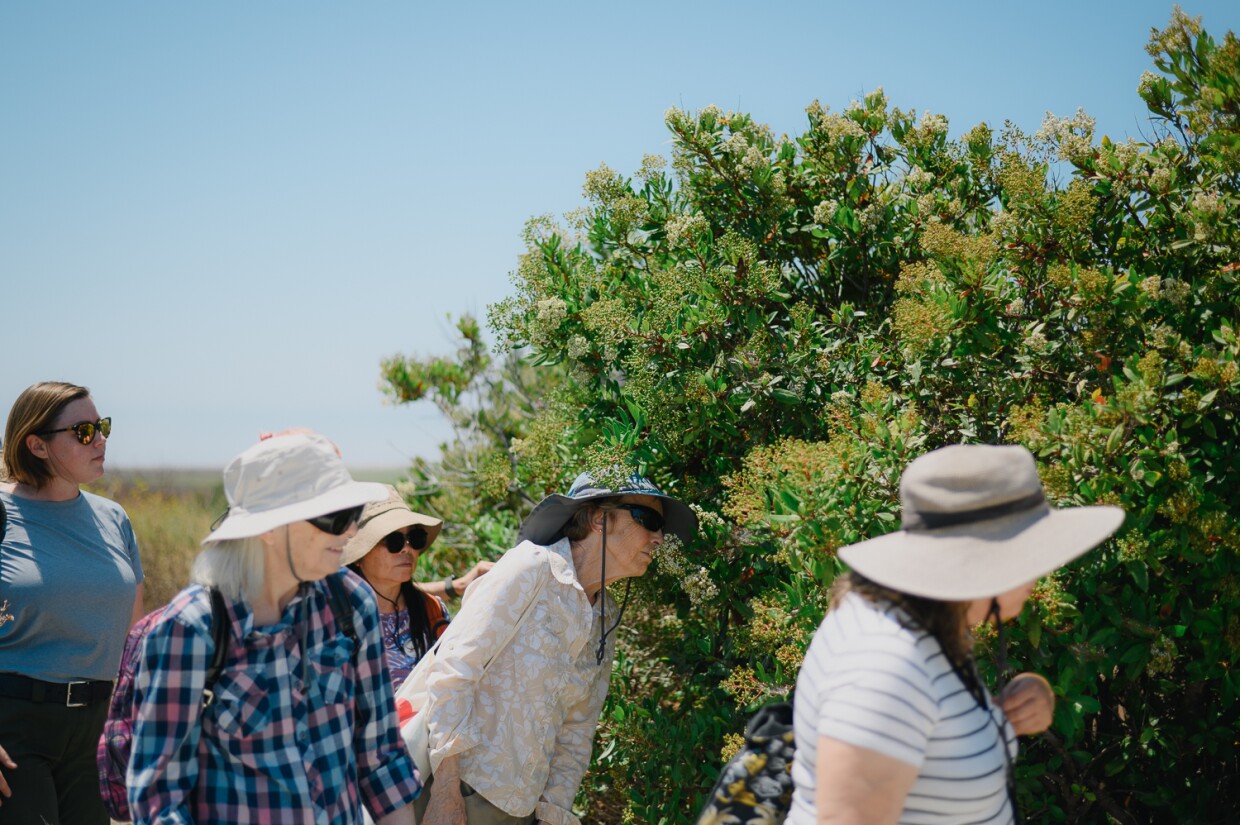This story is part of a new series about unique and unexpected ways that volunteers are spending their time across the San Diego region.
Ron Peterson counted his steps carefully. Two steps forward. Two to the side. He reached out, fingers gingerly brushing the air, looking for what he knew should be there.
And he found it: a Fremont cottonwood sapling, thin but sturdy, with flowing leaves shaped like spades from a deck of cards. It was sprouting from the foot of a tilting older cottonwood tree, at the edge of a trickling stream. This is one of Peterson’s favorite spots to visit at the Tijuana River Estuary, where he volunteers as a tour guide.
“If there's a strong breeze, they'll vibrate a little bit,” Peterson said as he pointed to the sapling’s leaves, earlier this month. Around him, a small tour group leaned in to listen. “That vibration causes the tree to kind of shimmer, or some people say murmur, in a breeze.”
Peterson’s tour is unique across the California state parks system. Five years ago, he lost his vision to the slow-moving nerve damage of glaucoma. He still remembers what the estuary looks like, but he can’t see it anymore.
Instead, Peterson has learned how to navigate the wetlands and recognize nearly 40 native plants by touch, smell and sound alone. Now, he leads a special nature walk called “The Eye-Opening Experience Without Sight,” where he teaches visitors to experience the estuary through those other senses.
“I think it's a unique opportunity for people to be able to experience it that way,” said Anne Marie Tipton, who works as the education coordinator at the estuary and serves on a diversity and accessibility committee inside the federal National Oceanic and Atmospheric Administration. “I haven't heard any other thing that's even close.”



Peterson first started visiting the Tijuana River Estuary after moving to Imperial Beach a decade ago.
The retired Navy scientist and engineer lived just blocks away from Imperial Beach Boulevard, where the wetlands push into the heart of the city. Peterson had loved spending time outdoors since joining the Boy Scouts when he was young, and the estuary became a second home. He began volunteering, helping to uproot invasive plants and clear trails.
But in the following years, Peterson’s vision began to get worse. He had dealt with glaucoma before, but the same treatments and surgeries were no longer helping. One day in 2019, he walked into Costco with his wife Darcy. The lights were on, but to Peterson, the room was so dark that he could barely see anything.
Still, Peterson refused to believe that it was happening. He tried to continue volunteering at the estuary, using bright cones to identify which plants needed to be watered.
But within a month of that Costco trip, he had gone almost completely blind. Losing his ability to travel and experience the natural landscape sent Peterson into a deep depression for several months.
“It was frightening,” he said. “I felt very much alone, and I felt that I didn't know how I was going to enjoy life anymore.”
It was at the estuary that Peterson found a way to move forward.
The Tijuana River Estuary is the largest coastal wetland in Southern California – a sweeping marsh that forms where the river meets the sea and that reaches from the northern edge of Tijuana upwards into the center of Imperial Beach.
The estuary is widely known for being the center of the cross-border sewage crisis. But the region is also home to dozens of native plants and hundreds of migrating birds, and is the site of decades of restoration work. It’s one of 30 federal reserves that serve as “living laboratories” for scientists working to protect wetland ecosystems.
The estuary already had several established nature walks, particularly for bird-watchers. But with the help of staff members, Peterson began developing a new kind of tour. His goal was to learn how to identify as many native plants as possible without sight and to share that knowledge with visitors.

Peterson now leads his tour every month. He takes visitors around the northern end of the estuary and introduces more than a dozen native plants.
There are the lemonade berries, which draw in buzzing honeybees as they grow sweet and sticky. There are the silky-soft leaves of the indian mallow, which Peterson lovingly compares to the ears of his labrador guide dog, Gidget. There is incense-smelling sage and the shimmering whisper of the cottonwood leaves.
Peterson’s favorite plant is the bladderpod, a waxy bush with yellow flowers and drooping pockets of seeds that harden into rattling shells. It’s not the prettiest plant, but he enjoys introducing it because of its noxious smell and its nickname – “pedo de bruja,” or “witch’s fart.”
He also works to include the ancestral uses of many plants from the Kumeyaay people, the original native inhabitants of San Diego County.



Tipton said Peterson’s tours are pushing the estuary to improve their access for disabled visitors.
“People with disabilities, it’s hard for us to sometimes integrate into society,” Tipton said. “I think that's really amazing that he's trying to show other people how to be independent.”
Peterson said leading these tours has helped him move forward from losing his vision. He said giving his time shifts his focus away from feeling sorry for himself and onto helping other people. And he is also proud to be connecting visitors to the estuary with native plants, which he sees as part of their broader mission of protecting the planet.
“I am happier today than I've ever been at any point in my life,” he said.


Back at the foot of that tilting cottonwood tree, Peterson bowed his head, listening for the sound of the wind in the leaves.
“I believe it has to do with the shape of the leaves,” he said. “I think it's an aerodynamics phenomenon such that, when the wind blows, they vibrate in such a manner to give off a sound from the tree itself.”
Peterson stood there for a moment, silent. But the air was still, and the sound of helicopters from the nearby naval air station drowned out any noise.
“I'm not hearing it now,” he said. “But if it was blowing harder, and if it were very quiet…”
He trailed off. As the helicopters faded in the distance, a breeze arrived. It swirled through the leaves above him, and they began to flutter like hundreds of emerald butterflies about to take flight.
“Maybe I can,” he said quietly. “Yeah. I think I’m hearing the sound of the cottonwood.”







